![[Previous]](../../../buttons/fprev.png)
![[Next]](../../../buttons/fnext.png)
DTC P0137: Heated
Oxygen Sensor (rear) Circuit Low Voltage
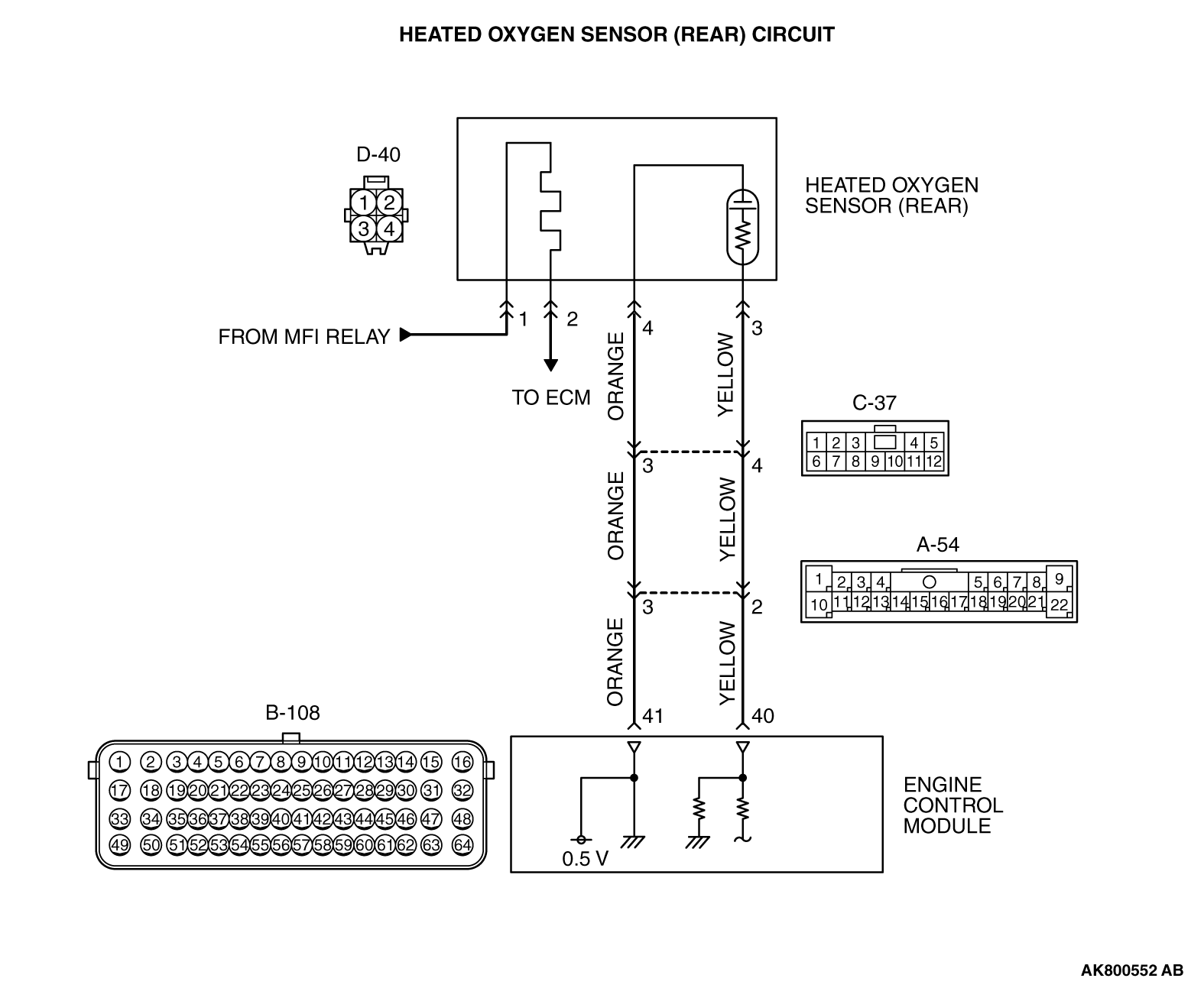
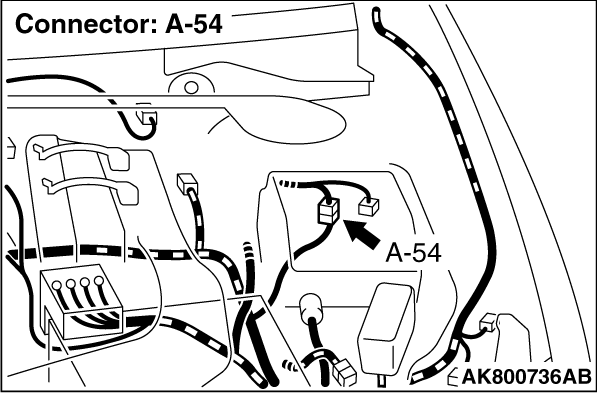
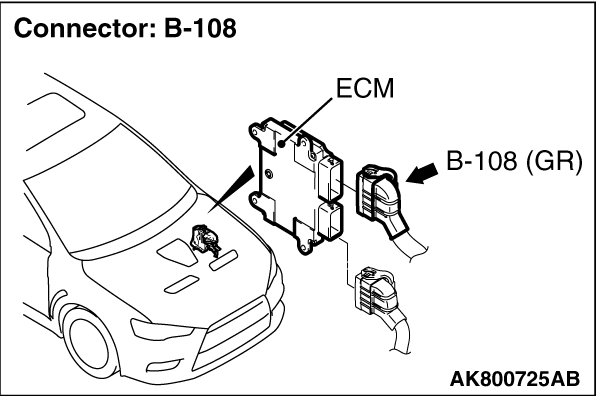
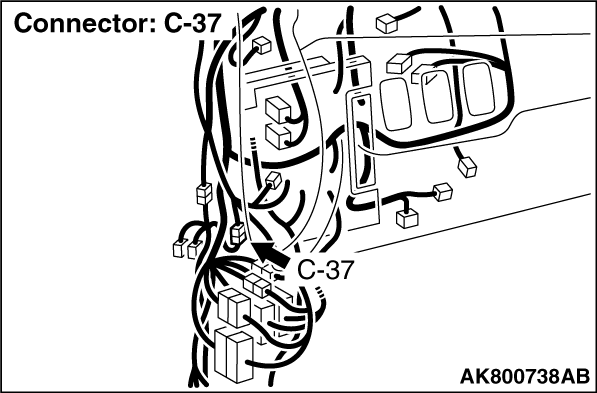
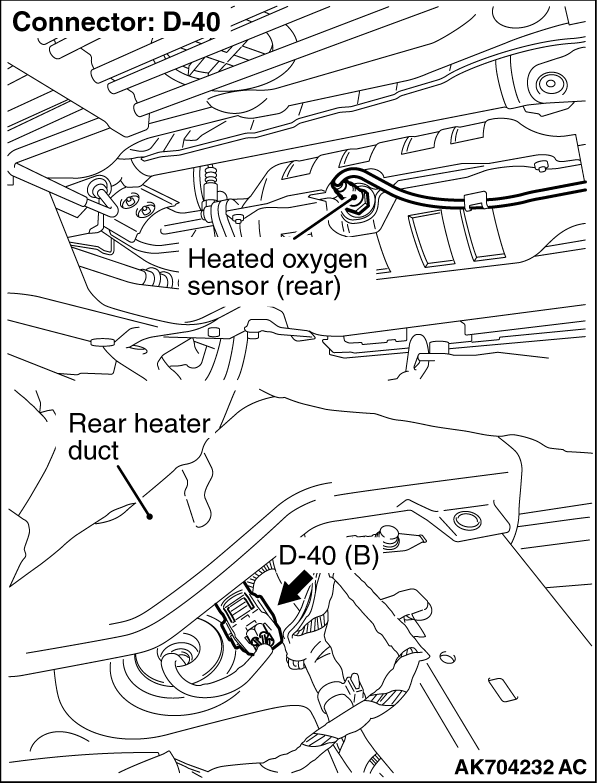
CIRCUIT OPERATION
- A voltage corresponding to the oxygen concentration in
the exhaust gas is sent to the ECM (terminal No. 40) from the output terminal (terminal No.
3) of the heated oxygen sensor (rear).
- Terminal No. 4 of the heated oxygen sensor (rear) is grounded with ECM (terminal
No. 41).
- The ECM applies an offset voltage of 0.5 volt to terminal No. 4 of the heated oxygen
sensor (rear).
TECHNICAL DESCRIPTION
- The output signal of the heated oxygen sensor (front)
is compensated by the output signal of the heated oxygen sensor (rear).
- The ECM checks for the heated oxygen sensor (rear) output voltage.
DESCRIPTIONS OF MONITOR METHODS
Heated oxygen sensor (rear) output voltage is under the
specified range.
MONITOR EXECUTION
MONITOR EXECUTION CONDITIONS (Other monitor and Sensor)
Other Monitor (There is no temporary DTC stored in memory
for the item monitored below)
- Heated oxygen sensor (front) monitor
- Heated oxygen sensor (front) heater monitor
- Heated oxygen sensor (rear) heater monitor
- Heated oxygen sensor (front) inactive monitor
- Heated oxygen sensor offset voltage monitor
- Air/fuel ratio feedback monitor
Sensor (The sensor below is determined to be normal)
- Mass airflow sensor
- Engine coolant temperature sensor
- Intake air temperature sensor
- Barometric pressure sensor
DTC SET CONDITIONS
Logic Flow Chart
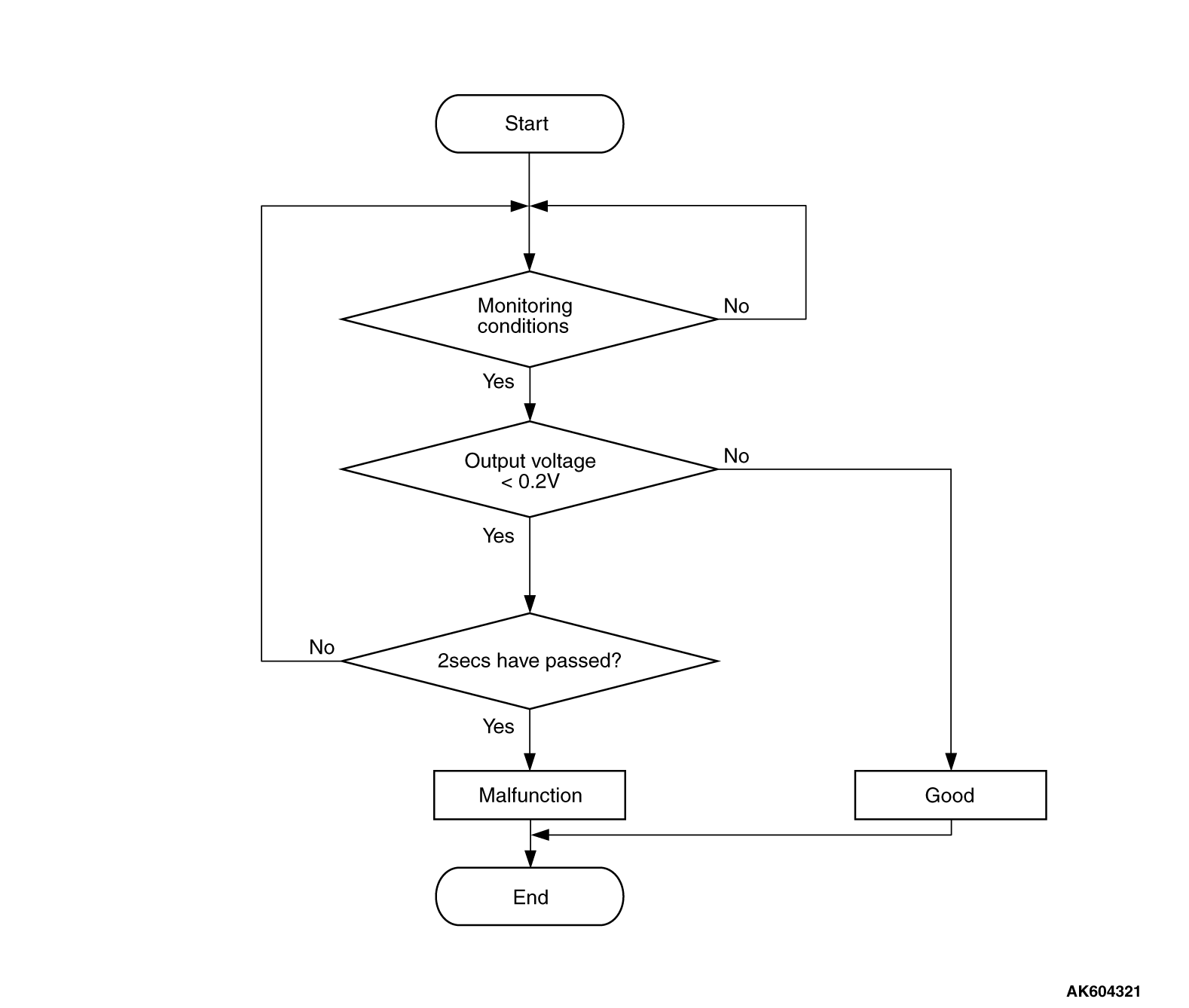
Check Conditions
- Heated oxygen sensor offset voltage is between 0.4 and 0.6 volt.
- Battery positive voltage is between 11 and 16.5 volts.
- More than 3 minutes have passed since the engine starting sequence was completed.
Judgement Criterion
- Heated oxygen sensor (rear) output voltage is less than 0.2 volt for 2 seconds.
FAIL-SAFE AND BACKUP FUNCTION
OBD-II DRIVE CYCLE PATTERN
Refer to Diagnostic Function - OBD-II Drive Cycle - Pattern
22  .
.
TROUBLESHOOTING HINTS (The most likely causes for this code to be set are:)
- Heated oxygen sensor (rear) failed.
- Open or shorted circuit in heated oxygen sensor (rear) output line or harness damage.
- Open circuit in heated oxygen sensor (rear) ground line or harness damage.
- Connector damage.
- ECM failed.
|
|
Required Special Tools:
- MB991958: Scan Tool (M.U.T.-III Sub Assembly)
- MB991824: V.C.I.
- MB991827: USB Cable
- MB991910: Main Harness A
- MB991658: Test Harness
- MB992110: Power Plant ECU Check Harness
|
|
|
STEP 1. Using scan tool MB991958, check data list item AD:
Heated Oxygen Sensor (rear).
|
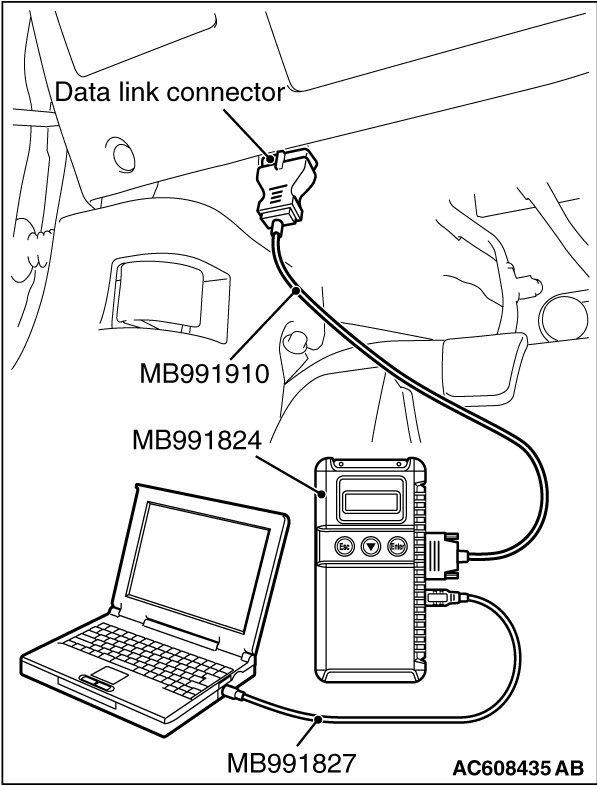
|
| caution |
To prevent damage to scan tool MB991958, always turn the ignition switch to the "LOCK"
(OFF) position before connecting or disconnecting scan tool MB991958.
|
(1)Connect scan tool MB991958 to the data link connector.
(2)Start the engine and run at idle.
(3)Set scan tool MB991958 to the data reading mode for item AD, Heated Oxygen Sensor
(rear).
- Transaxle: 2nd speed
- Drive with wide open throttle
- Engine: 3,500 r/min or more
- The output voltages should be between 0.6 and 1.0 volt.
(4)Turn the ignition switch to the "LOCK" (OFF) position.
Q.
Is the sensor operating properly?
 It can be assumed that this malfunction is intermittent. Refer to GROUP 00, How
to Use Troubleshooting/Inspection Service Points - How to Cope with Intermittent
Malfunctions It can be assumed that this malfunction is intermittent. Refer to GROUP 00, How
to Use Troubleshooting/Inspection Service Points - How to Cope with Intermittent
Malfunctions  . .
 Go to Step 2. Go to Step 2.
|
|
|
STEP 2. Measure the sensor output voltage at heated oxygen sensor
(rear) connector D-40 by backprobing
|
|
|
(1)Do not disconnect the connector D-40.
|
|
|
(2)Start the engine and run at idle.
|
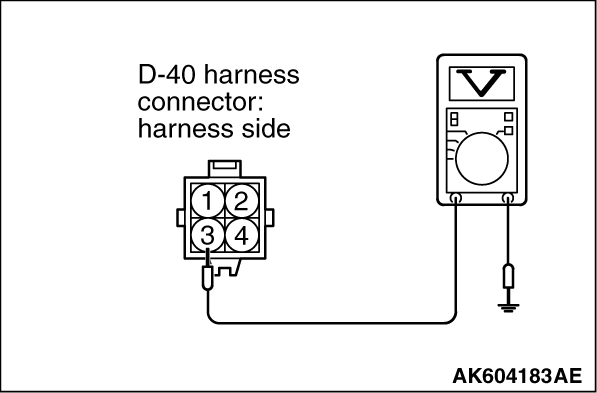
|
(3)Measure the voltage between terminal No. 3 and ground by backprobing under the following
driving.
- Transaxle: 2nd speed
- Drive with wide open throttle
- Engine: 3,500 r/min or more
- The output voltage should be between 1.0 and 1.5 volts.
(4)Turn the ignition switch to the "LOCK" (OFF) position.
Q.
Is the measured voltage within the specified range?
 Go to Step 3. Go to Step 3.
 Go to Step 8. Go to Step 8.
|
|
|
STEP 3. Check harness connector B-108 at ECM for damage.
|
|
|
Q.
Is the harness connector in good condition?
|
|
|
 Go to Step 4. Go to Step 4.
|
|
|
|
|
|
 Repair or replace it. Refer to GROUP 00E, Harness Connector Inspection Repair or replace it. Refer to GROUP 00E, Harness Connector Inspection  .
Then go to Step 14. .
Then go to Step 14.
|
|
|
|
|
|
STEP 4. Measure the sensor output voltage at ECM connector B-108 by
using power plant ECU check harness special tool MB992110.
|
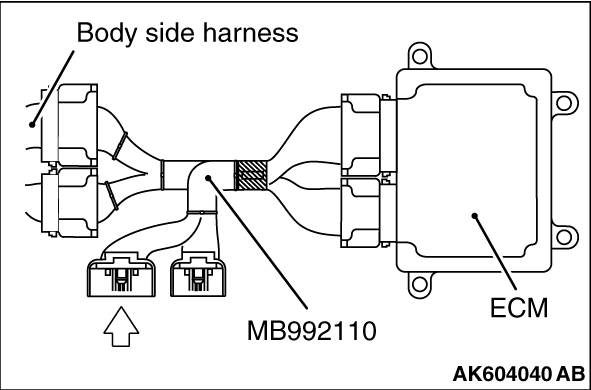
|
(1)Disconnect all ECM connectors. Connect the power plant ECU check harness special
tool MB992110 between the separated connectors.
(2)Start the engine and run at idle.
|
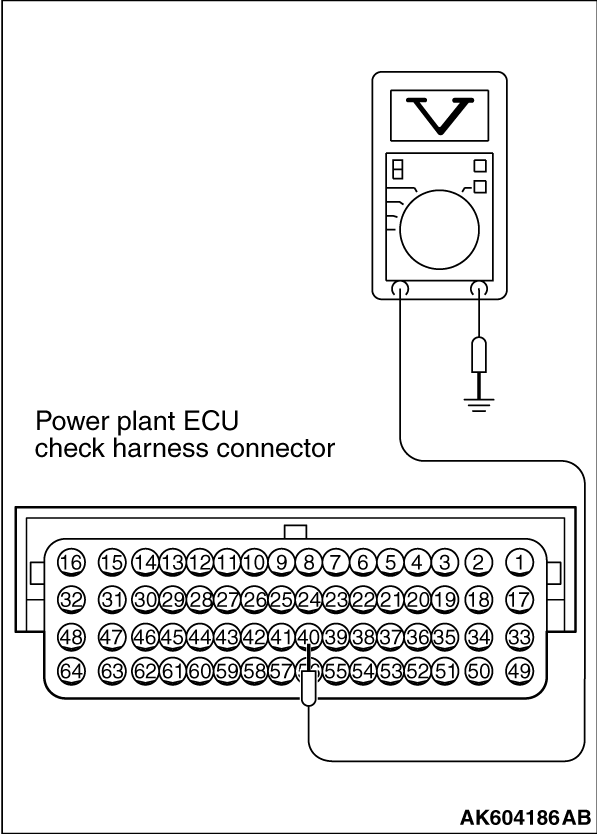
|
(3)Measure the voltage between terminal No. 40 and ground under the following driving.
- Transaxle: 2nd speed
- Drive with wide open throttle
- Engine: 3,500 r/min or more
- The output voltage should be between 1.0 and 1.5 volts.
(4)Turn the ignition switch to the "LOCK" (OFF) position.
Q.
Is the measured voltage between 1.0 and 1.5 volts?
 Go to Step 5. Go to Step 5.
 Go to Step 7. Go to Step 7.
|
|
|
STEP 5. Check harness connector D-40 at heated oxygen sensor (rear)
for damage.
|
|
|
Q.
Is the harness connector in good condition?
|
|
|
 Go to Step 6. Go to Step 6.
|
|
|
|
|
|
 Repair or replace it. Refer to GROUP 00E, Harness Connector Inspection Repair or replace it. Refer to GROUP 00E, Harness Connector Inspection  .
Then go to Step 14. .
Then go to Step 14.
|
|
|
|
|
|
STEP 6. Using scan tool MB991958, check data list item AD: Heated
Oxygen Sensor (rear).
|
|
|
(1)Start the engine and run at idle.
|
|
|
(2)Set scan tool MB991958 to the data reading mode for item AD, Heated Oxygen Sensor
(rear).
- Transaxle: 2nd speed
- Drive with wide open throttle
- Engine: 3,500 r/min or more
- The output voltage should be between 0.6 and 1.0 volt.
|
|
|
(3)Turn the ignition switch to the "LOCK" (OFF) position.
|
|
|
Q.
Is the sensor operating properly?
|
|
|
 It can be assumed that this malfunction is intermittent. Refer to GROUP 00, How
to Use Troubleshooting/Inspection Service Points - How to Cope with Intermittent
Malfunctions It can be assumed that this malfunction is intermittent. Refer to GROUP 00, How
to Use Troubleshooting/Inspection Service Points - How to Cope with Intermittent
Malfunctions  . .
|
|
|
|
|
|
 Replace the ECM. When the ECM is replaced, register the ID code. Refer to GROUP
42B, Diagnosis - ID Code Registration Necessity Judgment Table <Vehicles with KOS> Replace the ECM. When the ECM is replaced, register the ID code. Refer to GROUP
42B, Diagnosis - ID Code Registration Necessity Judgment Table <Vehicles with KOS>  or
GROUP 42C, Diagnosis - ID Codes Registration Judgment Table <Vehicles with WCM> or
GROUP 42C, Diagnosis - ID Codes Registration Judgment Table <Vehicles with WCM>  .
Then go to Step 14. .
Then go to Step 14.
|
|
|
|
|
|
STEP 7. Check harness connector D-40 at heated oxygen sensor (rear)
for damage.
|
|
|
Q.
Is the harness connector in good condition?
|
|
|
 Check harness connectors A-54 and C-37 at intermediate connectors for damage,
and repair or replace as required. Refer to GROUP 00E, Harness Connector Inspection Check harness connectors A-54 and C-37 at intermediate connectors for damage,
and repair or replace as required. Refer to GROUP 00E, Harness Connector Inspection  .
If intermediate connectors are in good condition, repair harness wire between heated oxygen
sensor (rear) connector D-40 (terminal No. 3) and ECM connector B-108 (terminal No. 40) because
of open circuit or harness damage. Then go to Step 14. .
If intermediate connectors are in good condition, repair harness wire between heated oxygen
sensor (rear) connector D-40 (terminal No. 3) and ECM connector B-108 (terminal No. 40) because
of open circuit or harness damage. Then go to Step 14.
|
|
|
|
|
|
 Repair or replace it. Refer to GROUP 00E, Harness Connector Inspection Repair or replace it. Refer to GROUP 00E, Harness Connector Inspection  .
Then go to Step 14. .
Then go to Step 14.
|
|
|
|
|
|
STEP 8. Check harness connector D-40 at heated oxygen sensor (rear)
for damage.
|
|
|
Q.
Is the harness connector in good condition?
|
|
|
 Go to Step 9. Go to Step 9.
|
|
|
|
|
|
 Repair or replace it. Refer to GROUP 00E, Harness Connector Inspection Repair or replace it. Refer to GROUP 00E, Harness Connector Inspection  .
Then go to Step 14. .
Then go to Step 14.
|
|
|
|
|
|
STEP 9. Check harness connector B-108 at ECM for damage.
|
|
|
Q.
Is the harness connector in good condition?
|
|
|
 Go to Step 10. Go to Step 10.
|
|
|
|
|
|
 Repair or replace it. Refer to GROUP 00E, Harness Connector Inspection Repair or replace it. Refer to GROUP 00E, Harness Connector Inspection  .
Then go to Step 14. .
Then go to Step 14.
|
|
|
|
|
|
STEP 10. Measure the sensor offset voltage at ECM connector B-108
by using power plant ECU check harness special tool MB992110.
|

|
(1)Disconnect all ECM connectors. Connect the power plant ECU check harness special
tool MB992110 between the separated connectors.
(2)Turn the ignition switch to the "ON" position.
|
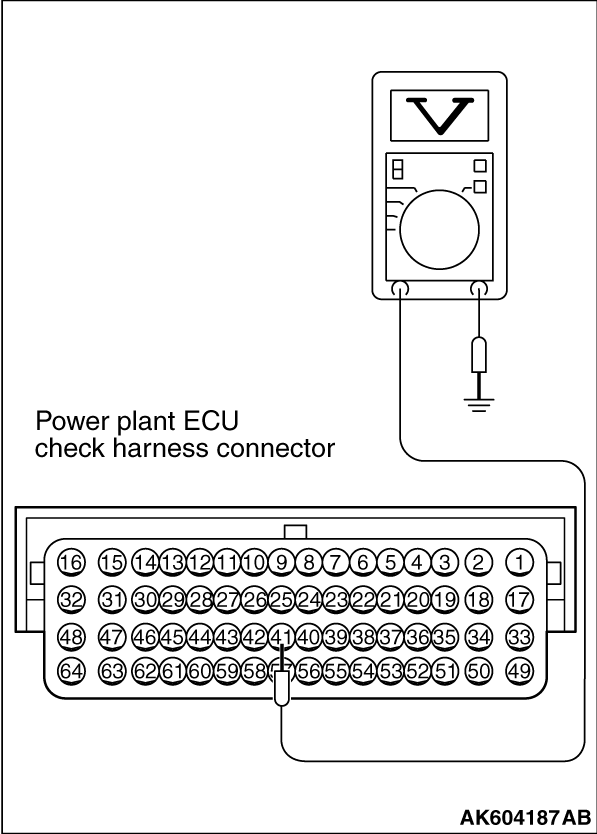
|
(3)Measure the voltage between terminal No. 41 and ground.
- Voltage should be between 0.4 and 0.6 volt.
(4)Turn the ignition switch to the "LOCK" (OFF) position.
Q.
Is the measured voltage between 0.4 and 0.6 volt?
 Go to Step 11. Go to Step 11.
 Check harness connectors A-54 and C-37 at intermediate connectors for damage,
and repair or replace as required. Refer to GROUP 00E, Harness Connector Inspection Check harness connectors A-54 and C-37 at intermediate connectors for damage,
and repair or replace as required. Refer to GROUP 00E, Harness Connector Inspection  .
If intermediate connectors are in good condition, repair harness wire between heated oxygen
sensor (rear) connector D-40 (terminal No. 4) and ECM connector B-108 (terminal No. 41) because
of short circuit to ground. Then go to Step 14. .
If intermediate connectors are in good condition, repair harness wire between heated oxygen
sensor (rear) connector D-40 (terminal No. 4) and ECM connector B-108 (terminal No. 41) because
of short circuit to ground. Then go to Step 14.
|
|
|
STEP 11. Check for open circuit and harness damage between heated
oxygen sensor (rear) connector D-40 (terminal No. 4) and ECM connector B-108 (terminal No. 41).
|
|
|
| note |
Check harness after checking intermediate connectors A-54 and C-37. If intermediate connectors
are damaged, repair or replace them. Refer to GROUP 00E, Harness Connector Inspection  .
Then go to Step 14. .
Then go to Step 14.
|
|
|
|
Q.
Is the harness wire in good condition?
|
|
|
 Go to Step 12. Go to Step 12.
|
|
|
|
|
|
 Repair it. Then go to Step 14. Repair it. Then go to Step 14.
|
|
|
|
|
|
STEP 12. Check for short circuit to ground between heated oxygen sensor
(rear) connector D-40 (terminal No. 3) and ECM connector B-108 (terminal No. 40).
|
|
|
| note |
Check harness after checking intermediate connectors A-54 and C-37. If intermediate connectors
are damaged, repair or replace them. Refer to GROUP 00E, Harness Connector Inspection  .
Then go to Step 14. .
Then go to Step 14.
|
|
|
|
Q.
Is the harness wire in good condition?
|
|
|
 Go to Step 13. Go to Step 13.
|
|
|
|
|
|
 Repair it. Then go to Step 14. Repair it. Then go to Step 14.
|
|
|
|
|
|
STEP 13. Check the heated oxygen sensor (rear).
|
|
|
(1)Disconnect the heated oxygen sensor (rear) connector D-40 and connect test harness
special tool MB991658 to the connector on the heated oxygen sensor (rear) side.
|
|
|
(2)Warm up the engine until engine coolant temperature reaches 80°C (176°F)
or higher.
|
|
|
(3)Drive at 50 km/h (31mph) or more for 10 minutes.
|
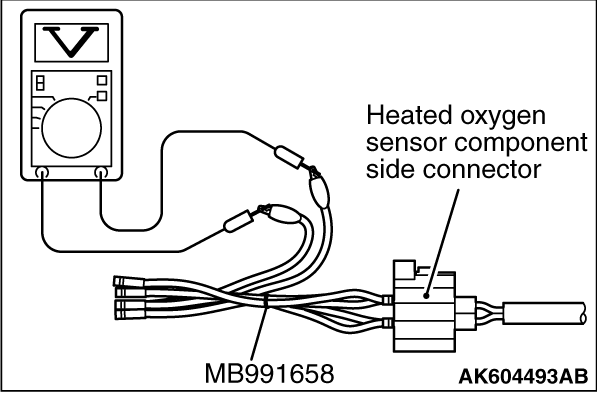
|
(4)Connect a digital voltage meter between terminal No. 3 and terminal No. 4.
(5)Measure the output voltage of heated oxygen sensor under the following driving.
- Transaxle: 2nd speed
- Drive with wide open throttle
- Engine: 3,500 r/min or more
Standard value: 0.6 - 1.0 V
| note |
If the temperature of sensing area does not reach the high temperature [of approximately
400°C (752°F) or more] even though the heated oxygen sensor is normal,
the output voltage would be possibly low in spite of the rich air/fuel ratio.
|
| note |
When the vehicle is driven with high loads, the temperature of the sensing area of the
heated oxygen sensor is sufficiently high. Thus, it is not necessary to apply the voltage to
the heater.
|
Q.
Is the measured voltage between 0.6 and 1.0 volt?
 Replace the ECM. When the ECM is replaced, register the ID code. Refer to GROUP
42B, Diagnosis - ID Code Registration Necessity Judgment Table <Vehicles with KOS> Replace the ECM. When the ECM is replaced, register the ID code. Refer to GROUP
42B, Diagnosis - ID Code Registration Necessity Judgment Table <Vehicles with KOS>  or
GROUP 42C, Diagnosis - ID Codes Registration Judgment Table <Vehicles with WCM> or
GROUP 42C, Diagnosis - ID Codes Registration Judgment Table <Vehicles with WCM>  .
Then go to Step 14. .
Then go to Step 14.
 Replace the heated oxygen sensor (rear). Then go to Step 14. Replace the heated oxygen sensor (rear). Then go to Step 14.
|
|
|
STEP 14. Test the OBD-II drive cycle.
|
|
|
(1)Carry out a test drive with the drive cycle pattern. Refer to Diagnostic Function - OBD-II
Drive Cycle - Pattern 22  . .
|
|
|
(2)Check the diagnostic trouble code (DTC).
|
|
|
 Retry the troubleshooting. Retry the troubleshooting.
|
|
|
|
|
|
 The inspection is complete. The inspection is complete.
|
|
|
|
 .
.![[Previous]](../../../buttons/fprev.png)
![[Next]](../../../buttons/fnext.png)






 .
.
 Go to Step 3.
Go to Step 3. Go to Step 8.
Go to Step 8. Go to Step 4.
Go to Step 4. Repair or replace it. Refer to GROUP 00E, Harness Connector Inspection
Repair or replace it. Refer to GROUP 00E, Harness Connector Inspection  .
Then go to Step 14.
.
Then go to Step 14.

 Go to Step 5.
Go to Step 5. Go to Step 7.
Go to Step 7. Go to Step 6.
Go to Step 6. Repair or replace it. Refer to GROUP 00E, Harness Connector Inspection
Repair or replace it. Refer to GROUP 00E, Harness Connector Inspection  .
Then go to Step 14.
.
Then go to Step 14. It can be assumed that this malfunction is intermittent. Refer to GROUP 00, How
to Use Troubleshooting/Inspection Service Points - How to Cope with Intermittent
Malfunctions
It can be assumed that this malfunction is intermittent. Refer to GROUP 00, How
to Use Troubleshooting/Inspection Service Points - How to Cope with Intermittent
Malfunctions  .
. Replace the ECM. When the ECM is replaced, register the ID code. Refer to GROUP
42B, Diagnosis - ID Code Registration Necessity Judgment Table <Vehicles with KOS>
Replace the ECM. When the ECM is replaced, register the ID code. Refer to GROUP
42B, Diagnosis - ID Code Registration Necessity Judgment Table <Vehicles with KOS>  or
GROUP 42C, Diagnosis - ID Codes Registration Judgment Table <Vehicles with WCM>
or
GROUP 42C, Diagnosis - ID Codes Registration Judgment Table <Vehicles with WCM>  .
Then go to Step 14.
.
Then go to Step 14. Check harness connectors A-54 and C-37 at intermediate connectors for damage,
and repair or replace as required. Refer to GROUP 00E, Harness Connector Inspection
Check harness connectors A-54 and C-37 at intermediate connectors for damage,
and repair or replace as required. Refer to GROUP 00E, Harness Connector Inspection  .
If intermediate connectors are in good condition, repair harness wire between heated oxygen
sensor (rear) connector D-40 (terminal No. 3) and ECM connector B-108 (terminal No. 40) because
of open circuit or harness damage. Then go to Step 14.
.
If intermediate connectors are in good condition, repair harness wire between heated oxygen
sensor (rear) connector D-40 (terminal No. 3) and ECM connector B-108 (terminal No. 40) because
of open circuit or harness damage. Then go to Step 14. Repair or replace it. Refer to GROUP 00E, Harness Connector Inspection
Repair or replace it. Refer to GROUP 00E, Harness Connector Inspection  .
Then go to Step 14.
.
Then go to Step 14. Go to Step 9.
Go to Step 9. Repair or replace it. Refer to GROUP 00E, Harness Connector Inspection
Repair or replace it. Refer to GROUP 00E, Harness Connector Inspection  .
Then go to Step 14.
.
Then go to Step 14. Go to Step 10.
Go to Step 10. Repair or replace it. Refer to GROUP 00E, Harness Connector Inspection
Repair or replace it. Refer to GROUP 00E, Harness Connector Inspection  .
Then go to Step 14.
.
Then go to Step 14.

 Go to Step 11.
Go to Step 11. Check harness connectors A-54 and C-37 at intermediate connectors for damage,
and repair or replace as required. Refer to GROUP 00E, Harness Connector Inspection
Check harness connectors A-54 and C-37 at intermediate connectors for damage,
and repair or replace as required. Refer to GROUP 00E, Harness Connector Inspection  .
If intermediate connectors are in good condition, repair harness wire between heated oxygen
sensor (rear) connector D-40 (terminal No. 4) and ECM connector B-108 (terminal No. 41) because
of short circuit to ground. Then go to Step 14.
.
If intermediate connectors are in good condition, repair harness wire between heated oxygen
sensor (rear) connector D-40 (terminal No. 4) and ECM connector B-108 (terminal No. 41) because
of short circuit to ground. Then go to Step 14. Go to Step 12.
Go to Step 12. Repair it. Then go to Step 14.
Repair it. Then go to Step 14. Go to Step 13.
Go to Step 13. Repair it. Then go to Step 14.
Repair it. Then go to Step 14.
 Replace the ECM. When the ECM is replaced, register the ID code. Refer to GROUP
42B, Diagnosis - ID Code Registration Necessity Judgment Table <Vehicles with KOS>
Replace the ECM. When the ECM is replaced, register the ID code. Refer to GROUP
42B, Diagnosis - ID Code Registration Necessity Judgment Table <Vehicles with KOS>  or
GROUP 42C, Diagnosis - ID Codes Registration Judgment Table <Vehicles with WCM>
or
GROUP 42C, Diagnosis - ID Codes Registration Judgment Table <Vehicles with WCM>  .
Then go to Step 14.
.
Then go to Step 14. Replace the heated oxygen sensor (rear). Then go to Step 14.
Replace the heated oxygen sensor (rear). Then go to Step 14. .
. Retry the troubleshooting.
Retry the troubleshooting. The inspection is complete.
The inspection is complete.